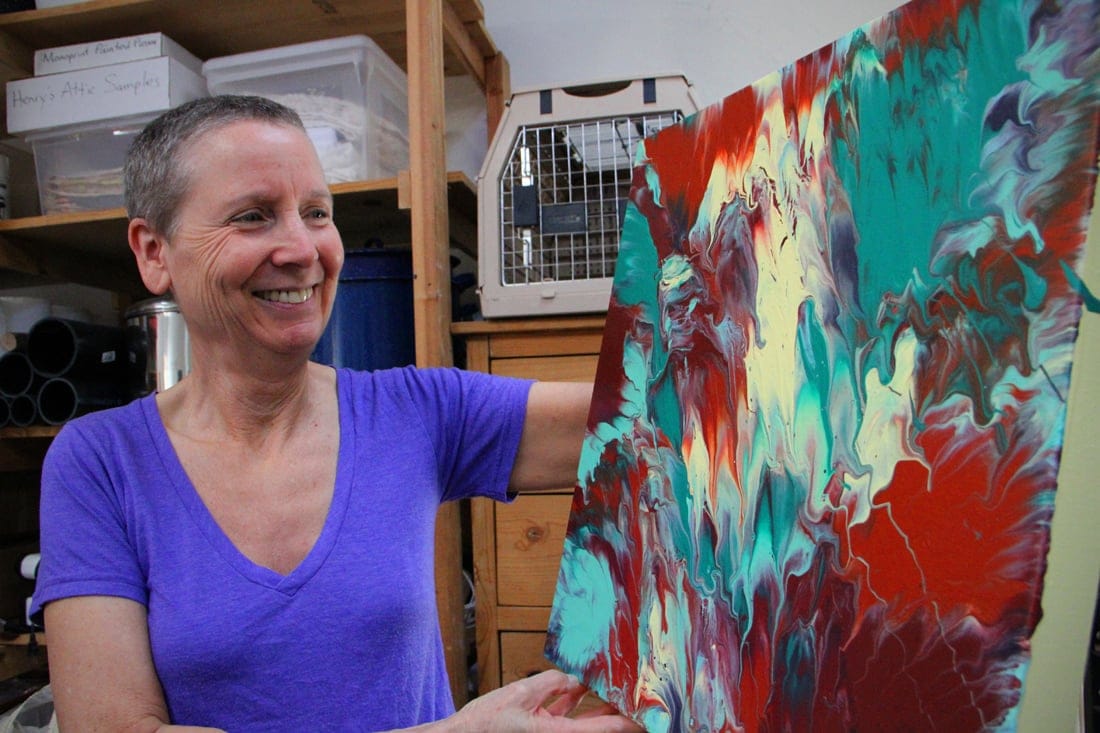
GRANT STREET — Painter Cassandra Tondro has studied art at UCLA, California State University at Northridge and the Otis College of Art and Design — and has thrown what she learned out the window.
Instead of painting oils and acrylics with delicate brushes like she was taught, she goes a few blocks down to the nearby Hazardous Waste Center and picks up cans of used paint to use in her art.
"I don't use traditional materials, I don't use traditional methods," Tondro said. "There's rules you're supposed to follow (in art school)... I've just never been really big on the rules."
The Santa Monica native's unconventional painting styles are ones she invented on her own, simply by observing little pieces of her surroundings.
She invented her own abstract painting style when she noticed paint dripping down from her canvas when it was propped up vertically. She said she was dismayed to see all the paint go to waste, and on a whim, she took a blank canvas and pressed it onto the paint that had seeped to the ground of her studio.
She liked the result, and has been pressing canvases into paint she arranges on a sheet of plastic ever since.
Tondro also discovered her own way of making leaf prints after seeing the way leaves stained a wet sidewalk. She thought up a way of making prints by taking leaves collected from her neighborhood walks, pressing them onto watercolor paper and steaming them.
Her small pink house sits on a quiet residential lane, far from the bustle of the Third Street Promenade and the Santa Monica Pier, is filled with her own unconventional creations — from her abstract paintings to a Campbell soup can she made into a candle for her dining table.
"(Art) is just so much a part of me," Tondro said. "I wake up in the morning thinking about it and I go to bed at night thinking about it."
It was always her hope to paint full-time, Tondro said. She tabled that dream when her college counselor suggested she go into computer programming instead, since she would likely always be employed. So Tondro became a skilled computer programmer, though she never loved the job.
It wasn't until 13 years ago that she finally got to pursue her dream, after earning enough savings from her computer programming work.
Tondro owns no professional art studio, and instead works in a little garage in the corner of her backyard. The studio is neatly kept, with about a hundred paint cans collected from the Hazardous Waste Center stacked in towers and a pair of paint-splattered pink Crocs tucked by the door.
Once a month, Tondro makes a trip a few blocks down to the Hazardous Waste Center, a facility where residents can drop off used materials like paint, batteries, fluorescent light tubes, pesticides and propane tanks to be properly disposed of or recycled. The center keeps a cabinet of materials that other residents can pick up for free the first Saturday of every month.
She comes often enough that the employees there know her, and she has even donated a couple of her paintings to decorate the office, said James Velez-Conway, senior administrative analyst at the Hazardous Waste Center.
Tondro's paintings are her way of helping to protect the environment, she said.
"Especially with all the talk the past 10-15 years about global climate change, I just got more and more concerned," Tondro said. "What can I do, what part do I play in this? That's part of why I use leftover materials or found materials for my art."
To spread awareness about recycling and green living, Tondro recently worked with Velez-Conway to put on a painting workshop for city residents, using latex paint from the center. They ended up distributing 500 canvases in just a few hours, Velez-Conway said.
Green art like Tondro's is not uncommon, nor is it a new trend, said Malina Moore, cultural affairs supervisor for the city. She said green art is appealing to many artists because it is inexpensive and provides a way to contribute to the environment.
"Artists have become more interested in incorporating their ways of thinking about their environment into their art," she said. "I imagine it's an interesting challenge ... to make something new out of something that's already in existence."
Tondro said she plans to hold another green art workshop in early September to help promote greener living.
She added that it can be hard for some artists to learn how to switch to reused materials rather than the traditional oil and acrylics. For her, though, experimentation and the unexpected were always her preference.
"I like it when I don't have control, when I don't know what's going to happen ... If it always worked out exactly as I expected, I mean, how boring would that be?" she said with a laugh.
editor@www.smdp.com

